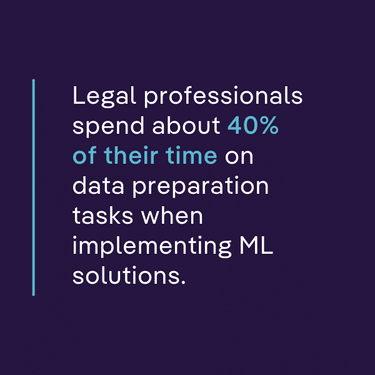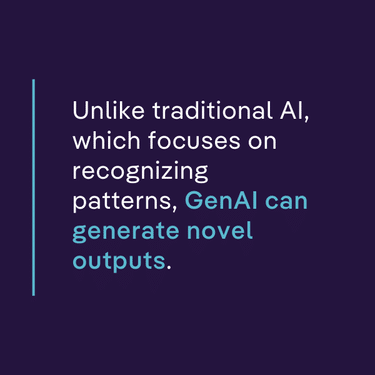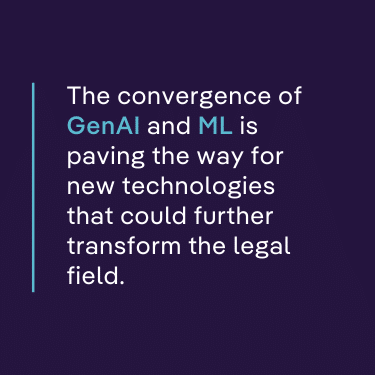Executive Summary
The legal industry is undergoing a technological revolution, with AI technologies like Generative AI (GenAI) and Machine Learning (ML) transforming traditional workflows. While both technologies enhance efficiency, their roles and applications differ significantly. This blog explores the distinctions between GenAI and ML, two pivotal AI advancements driving innovation in Legal Tech. Machine Learning has long been a cornerstone of legal tech, leveraging data patterns for tasks such as contract analysis, legal research, and predictive analytics. GenAI, however, represents a new frontier. With its ability to generate novel content, GenAI is revolutionizing tasks like contract drafting and legal document creation, offering faster deployment and deeper contextual understanding. This blog post highlights the importance of understanding these differences. While ML excels at processing structured data and identifying patterns, GenAI’s ability to work with unstructured data and produce creative, scalable outputs marks a significant leap forward. Legal professionals need to grasp these nuances to fully leverage the power of AI in their practices, improving efficiency, reducing risk, and staying competitive in a rapidly evolving landscape. Read the full blog to better understand these two technologies and discover why ContractPodAi is shifting towards a more GenAI-based approach for contract management solutions.
The legal industry is experiencing a rapid technological shift, with artificial intelligence (AI) leading the charge in transforming how legal professionals work. As AI continues to evolve, its potential to enhance efficiency and streamline complex legal tasks becomes increasingly clear. Among the most impactful advancements is the rise of GenAI, a technology that is reshaping traditional approaches to contract management and legal drafting.
Unlike conventional machine learning (ML), which has served as a foundation for AI solutions in Legal Tech, GenAI offers enhanced reasoning abilities, quicker deployment times, and a deeper understanding of legal language. According to Gartner, GenAI can reduce the time legal professionals spend on drafting documents by up to 70%, making it a game-changer for contract creation and legal drafting tasks. However, not all Legal Tech is created equal, and knowing the difference between GenAI and ML is crucial.
This blog post explores these two powerful technologies and how they can revolutionize the legal sector.
AI’s Impact on the Legal Industry
Artificial intelligence is making waves across various industries, and the legal sector is no exception. From automating mundane tasks to providing deep insights through data analysis, AI has the potential to redefine how legal professionals operate. However, it’s essential to discern between different types of AI to leverage their full potential.
Why Legal Professionals Need to Understand GenAI and Machine Learning
For legal professionals, distinguishing between GenAI and ML is critical. While both technologies offer significant advantages, they serve different purposes and are suited to different applications within the legal field. Misunderstanding these distinctions can lead to suboptimal implementations and missed opportunities.
What is Machine Learning?

Definition and Core Concepts
ML is a subset of AI that enables systems to learn from data and improve over time without being explicitly programmed. It relies on algorithms to identify patterns and make decisions based on historical data. Legal professionals spend approximately 40% of their time on data preparation tasks when implementing ML solutions.
Types of Machine Learning
Supervised Learning
Supervised learning involves training a model on labeled data, where the correct output is provided. This type of learning is commonly used for tasks such as classification and regression.
Unsupervised Learning
Unsupervised learning, on the other hand, deals with unlabeled data. The model identifies patterns and relationships within the dataset without predefined outputs, making it suitable for clustering and association tasks.
Reinforcement Learning
Reinforcement learning focuses on training models through trial and error, using rewards and penalties to guide behavior. This approach is often applied in scenarios where decision-making is sequential.
Examples of Machine Learning in Legal Applications
Contract Analysis
ML can streamline contract analysis by automatically identifying key clauses and flagging potential risks. This reduces the time and effort required for manual review.
Legal Research
Through natural language processing (NLP), ML can enhance legal research by quickly sifting through vast amounts of case law and legal documents to find relevant information.
Predictive Analytics for Case Outcomes
ML models can analyze historical case data to predict outcomes, providing valuable insights for legal strategy and decision-making.

What is GenAI?
GenAI is a type of AI that can create new content. Unlike traditional AI, which focuses on recognizing patterns, GenAI can generate novel outputs.
Key Differences Between GenAI and Machine Learning
Input and Output Characteristics
ML typically requires structured data and produces outputs based on historical patterns. In contrast, GenAI can work with unstructured data and generate new outputs.
Training Methodologies
ML models often require extensive training with large datasets and manual labeling. GenAI models, however, can learn from smaller, less structured datasets and adapt more quickly.
Creativity and Novelty in Outputs
While ML excels at identifying and replicating patterns, GenAI can create new, innovative content that goes beyond the limitations of its training data.
Scalability and Adaptability
GenAI is inherently more scalable and adaptable than traditional machine learning. It can rapidly generate new solutions and adapt to changing data, making it ideal for dynamic environments.
The Role of GenAI and Machine Learning in Contract Management

How ContractPodAi Leverages Both Technologies
ContractPodAi’s use of machine learning stems from over a decade of expertise, resources, and the accumulation of nearly 3,000 pre-trained data points through extensive AI implementations. However, machine learning (ML) alone is no longer sufficient for the demands of the evolving legal landscape.
As a result, ContractPodAi is transitioning to a GenAI strategy due to its superior scalability, enhanced reasoning capabilities, reduced training and tuning requirements, and significantly faster time to value.
ContractPodAi’s Evolution with Machine Learning
In 2015, ContractPodAi pioneered the integration of artificial intelligence in LegalTech, becoming the first to incorporate IBM Watson for data extraction during contract uploads. This breakthrough automated a previously manual process, allowing for the efficient extraction and organization of data. At the time, few LegalTech companies had ventured into machine learning, making ContractPodAi a trailblazer in the field.
While ML models proved effective, they required substantial investment in terms of both technology and personnel. Over the past decade, ContractPodAi built a dedicated team of data scientists and legal engineers to continuously train, fine-tune, and monitor these models. This investment yielded a repository of nearly 3,000 pre-trained data points, refined through hundreds of enterprise-level implementations. While this has optimized time-to-deployment for clients, new use cases still often require lengthy training and deployment schedules.
The Rise of GenAI
GenAI represents a significant leap forward for ContractPodAi. Unlike traditional ML, which requires extensive training to extract specific data points, GenAI has the ability to understand and generate human-like language with minimal fine-tuning. This makes it uniquely suited to processing complex legal clauses and providing reasoning.
For example, while traditional ML can be trained to identify key phrases like “natural disaster” in a “Force Majeure” clause, it struggles to interpret the nuanced variations that arise across jurisdictions. In contrast, GenAI can not only recognize these terms but also comprehend their legal implications, offering contextually accurate interpretations without requiring months of training.
Complementary Use Cases: ML vs. GenAI
Both ML and GenAI have their respective strengths. Machine learning remains highly effective in scenarios that require structured, repeatable extractions—such as identifying standard clauses that remain consistent across contracts. ContractPodAi’s ML models, honed through years of refinement, continue to deliver high accuracy in these use cases.
However, when advanced legal reasoning is required—such as interpreting vague clauses or resolving ambiguities—GenAI far exceeds traditional ML’s capabilities. For example, legal clauses related to “Indemnification” or “Limitation of Liability” often demand interpretation beyond simple data extraction. GenAI’s ability to reason through these complex legal frameworks allows for faster, more accurate insights, drastically reducing the need for model fine-tuning.
The Future of ContractPodAi: A GenAI Strategy
While ContractPodAi’s legacy ML models will continue to serve existing clients, the decisive shift toward GenAI will pave the way forward. This strategic move is based on several factors that position GenAI as the future of legal technology:
- Scalability: GenAI can process a broader variety of contract types and complexities without the need for extensive retraining.
- Superior Analysis and Reasoning: GenAI excels at understanding the context and nuances of legal language, whereas traditional ML focuses on extracting specific data points
- Reduced Fine-Tuning: GenAI models require significantly less fine-tuning, enabling faster deployment and greater adaptability to new legal frameworks
- Accelerated Time to Value: GenAI delivers meaningful results in a shorter time frame, allowing legal teams to focus on strategic initiatives instead of manual review
- Democratization of AI Training: ContractPodAi is empowering users by providing intuitive, user-friendly tools that enable legal professionals to configure AI models without requiring specialized data science expertise
ContractPodAi’s Experience as a Differentiator
With over a decade of experience deploying AI for legal use cases, ContractPodAi has developed an intimate understanding of both the strengths and limitations of traditional machine learning and GenAI. This expertise positions ContractPodAI to guide clients in selecting the right tools to meet their unique requirements, ensuring successful deployment and a clear return on investment. Whether a client aims to streamline contract creation, automate data extraction, or gain deeper insights into their contract portfolio, ContractPodAi has the technology and expertise to deliver on these objectives.
Future Trends: The Convergence of GenAI and Machine Learning

Emerging Technologies and Their Potential Impact on the Legal Field
The convergence of GenAI and ML is paving the way for new technologies that could further transform the legal field. These advancements promise to enhance efficiency, accuracy, and decision-making.
Preparing for the Future: Skills Legal Professionals Need to Develop
To stay ahead of the curve, legal professionals should develop skills in data analysis, AI ethics, and technology management. Understanding these technologies will be crucial in navigating the evolving landscape of legal tech. According to the 2023 Legal Technology Survey Report by the American Bar Association, 76% of respondents believe that developing skills in data analysis, AI ethics, and technology management is essential for future-proofing their legal careers. The report emphasizes the growing importance of these skills as AI continues to play a more significant role in the legal industry.
Ethical and Legal Considerations
Data Privacy and Security Concerns
AI technologies raise significant data privacy and security concerns. Legal professionals must ensure that AI implementations comply with regulations and protect sensitive client information.
Bias and Fairness in AI-Powered Legal Tools
Bias in AI algorithms can lead to unfair outcomes. It’s essential to continuously monitor and refine AI models to ensure fairness and avoid perpetuating systemic biases.
Regulatory Landscape for AI in Legal Tech
The regulatory landscape for AI is evolving rapidly. Legal professionals need to stay informed about new regulations and guidelines to ensure compliance and mitigate risks.
Recap of Key Differences Between GenAI and Machine Learning
Efficiency
ML often demands months of development and deployment time, whereas GenAI can be implemented almost instantly, allowing for immediate utilization.
Manual Tagging
While ML relies on manual tagging and predefined libraries, GenAI excels at auto-extracting information and comprehending unstructured text, enhancing its usability.

Customizability
Modifications to ML models typically depend on the vendor, but GenAI empowers clients to make adjustments according to their specific needs. By 2027, over 50% of GenAI models employed by enterprises will be domain-specific, tailored to either a specific industry or business function; a remarkable increase from just about 1% in 2023.
Explanation of Output
ML frequently encounters challenges when explaining its outputs and only about 30% of ML models accurately interpret natural language queries (Gartner, 2022). In contrast, GenAI offers clear rationales based on its understanding of underlying concepts, promoting transparency and comprehension and can process natural language.
The Importance of Understanding Both Technologies for Legal Professionals
For legal professionals, mastering both GenAI and ML is essential. These technologies can enhance efficiency, improve decision-making, and provide a competitive edge.
Machine Learning vs Generative AI FAQs
What Are the Main Advantages of GenAI Over Traditional Machine Learning for Legal Applications?
GenAI offers several key advantages over traditional machine learning (ML) for legal applications, particularly in handling complex language, scalability, and ease of deployment.
How Can Law Firms Effectively Implement GenAI and Machine Learning Technologies?
Law firms can start by identifying specific areas where AI can add value, such as contract analysis or legal research. Partnering with AI technology providers like ContractPodAI can facilitate seamless implementation.
How Does ContractPodAI Ensure the Accuracy and Reliability of Its AI-Powered Solutions?
ContractPodAi ensures the accuracy and reliability of its AI-powered solutions through a combination of extensive experience, continual model refinement, and the use of both ML and GenAI tailored to specific use cases.
Are you interested in learning more about ContractPodAi? Contact us today to request a demo.


